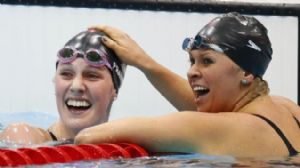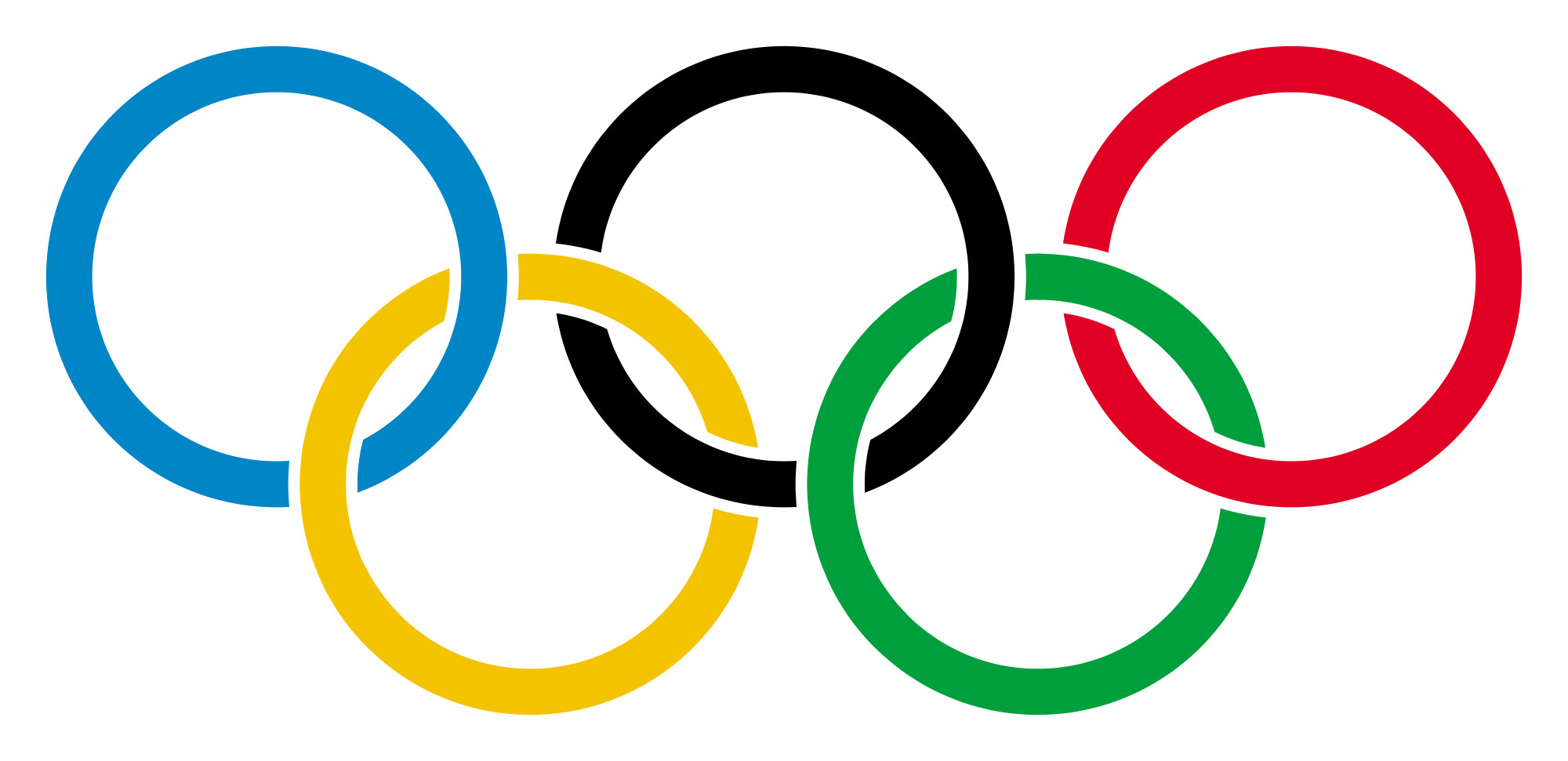BY ALAN ABRAHAMSON | JUN 29, 2012, 10:30 PM ET
 Matt Grevers pushes off the starting block in the final of the men's 100m backstroke.
Matt Grevers pushes off the starting block in the final of the men's 100m backstroke.
OMAHA -- Matt Grevers had just come off a dominating win in the 100 backstroke here at the U.S. Swim Trials. It was late at night. He was walking across the bridge that connects CenturyLink Arena to the Hilton Omaha and he was walking slowly, very slowly, because about every 10 feet, a gaggle of girls was asking for autographs and photos.
He was signing and posing and he could not have been more gracious, even when the girls gave way to a grown man who asked if he would pose for a photo with a picture glued to a popsicle-stick of his hometown orthodontist, apparently a swim dad. No matter.
Grevers posed for the photo and the guy gushed, "Matt, you just saved me two-thousand bucks!"
"It's a big family," Grevers would say later. "Everyone wants everyone to do well."
Every sport has its own culture. A reason, perhaps the key reason, for USA Swimming's ongoing success at the Summer Olympics -- and why the team that's being put together here at the Trials is expected to continue that run in just a few weeks in London -- is its underlying culture.
It's no accident. It begins early, when kids start at their clubs in their towns, and it carries all the way through and to the national and Olympic teams.
Just one example of swim culture, and how it contrasts with track and field, which of course will be one of the other marquee sports in just a few weeks at the Games:
In the women's 200-meter breaststroke heats here Friday morning, 14-year-old Allie Szekely and 20-year-old Gisselle Kohoyda tied for 17th in 2:30.28.
A marked element of swim culture is that swimmers are expected to be tough. About an hour later, after the heats of the men's 200 individual medley, they held a swim-off to determine who would be the first alternate for Friday night's semifinals in the women's 200 breaststroke. With the crowd roaring, Allie won, in 2:30.03.
To be clear: She went faster in the swim-off than she had in the heat itself.
Afterward, she signed autographs and said it was "awesome."
Compare: In track and field, the dead-heat in the women's 100 meters last Saturday in Eugene, Ore., is still a dead-heat.
The two athletes involved in the 100-meter tie at the track Trials, Allyson Felix and Jeneba Tarmoh, are also competing in the 200 meters. After competing through the early rounds of the 200, both have been escorted through what's called the "mixed zone," where athletes meet reporters, with no comment. Both have declined to speak with television crews as well.
The track dead-heat has dissolved into something of a farce. While the protocol that has since been instituted since the tie calls for either a run-off or a coin-flip, the coin-flip rules demand that the 25-cent piece to be used must feature George Washington on one side and an "Eagle" on the other. So the commemorative quarters honoring each of the 50 states, which are of course legal tender and now in wide circulation through a program launched by the U.S. Mint in 1999 -- they're no good.
Chuck Wielgus, executive director of USA Swimming, said he believes it's his No. 1 priority -- more than fund-raising, organizational charts, anything -- to work at culture.
On the blocks, swimming is the most important thing. Off, no. It's understood that there's a distinct difference between who the person is as a swimmer and who he or she is as a person. Moreover, the culture in USA Swimming is to embrace accountability and responsibility and, whether winning or losing, to be humble and gracious.
No one is perfect, of course, and there are obviously exceptions and mistakes. But that's the culture.
"You can't manufacture it," Wielgus said. "It has to be ingrained."
He also said, "At the very end, it can be that extra little shot of energy, that extra hundredth of a second that can make a difference. This -- all of it -- it's more than just about you."
It's all the more remarkable that it is ingrained because, obviously, swimming is an individual thing. But what USA Swimming has done is make it a team thing, too.
Swimming is hard. Not to say other sports aren't. But, as Eddie Reese, the longtime coach at the University of Texas, said, "Nobody in their right mind picks this. How exciting is it to do two to four hours a day following a black line at the bottom of a pool with no outside information or stimulus? Plus, the only way to get better is to work harder."
On top of which, as everyone in the sport's elite echelons understand well, the best way to produce Olympic-caliber stars is to develop an aerobic base in a young athlete before he or she hits puberty -- the best example being Michael Phelps, who was essentially a miler as a youngster in Baltimore before he started sprinting.
The thing is, as young swimmers are growing up in the sport, they are inevitably on clubs or teams. And there's a lot of waiting around together at meets for heats. That builds camaraderie.
That group sense thoroughly informs the national and Olympic teams.
Call it corny, but there are rookie skits and karaoke and team-building exercises that everyone buys into.
At the world championships last year in Shanghai, Frank Busch, the national team director, was a rookie. He had for the prior 22 years been the coach at the University of Arizona. But he was new to the national team post and therefore a rookie.
Culture is culture. At the pre-Shanghai training camp, Busch got up before the team and belted out his version of Bon Jovi's "Livin' on a Prayer." At the time, he was 60-years-old and, as he said with a laugh, "They looked at me like I was from outer space."
Missy Franklin, the 17-year-old Colorado sensation who is expected to be a breakout star in London, not only sang, she danced so well that, Busch said, "The kids on the team, they were pulling their jaw off the ground watching her."
Because Franklin will be an Olympic rookie, she will have to do something all over again at the team's training camp before London. Culture is culture.
Besides the fun, there is a serious element to it as well, which everyone involved calls "the code." On international trips, there's a curfew, typically 10 or 11 p.m. No girls in boys' rooms or vice-versa. No tobacco or alcohol, not even for coaches when they are eating out.
"I have never been on a trip where there has been a problem," said Lindsay Mintenko, who swam at the 2000 Sydney and 2004 Athens Games, winning three medals, two gold, and is now the U.S. national team managing director.
The way this also works is that the older athletes not only are expected to give back -- they want to do so.
Ariana Kukors, the 2009 world championship gold medalist in the women's 200 IM who qualified here to swim the event in London, said she vividly remembers Summer Sanders, who won four swimming medals, two gold, at the 1992 Barcelona Games, coming to a pool in the Seattle area -- where Kukors is from -- to sign autographs when Kukors was just 10.
"I never get tired of signing autographs," Kukors said.
Even the biggest names gladly pitch in.
In 2009, Phelps happened to be on vacation in Hawaii. The junior Pan Pacific championships were going on at the same time. Phelps called Jack Roach, the junior team national director, and said, what can I do?
Roach said, please come on over. Phelps did, and talked to the teens at length about the honor of representing team and country.
At those world championships in Rome in 2009, meanwhile, Aaron Peirsol, arguably the finest backstroker of his generation, didn't make the finals of the 100 back. He simply misjudged how fast he would have to go to make the last eight.
He didn't whine. He didn't complain. He said he would put it behind him, cheer for his teammates and get ready for his next race, the 200 back.
A few days later, right before he was getting ready to swim the 200 final, Peirsol turned to Roach, who on that trip was with the senior team.
"Jack, come here," Peirsol said. He urged Roach to take a look around at the magnificent setting that was the Foro Italico -- the olive trees, the red brick buildings, the noise and sound of 16,000 people.
"Let's not forget what we are doing," Peirsol said. "We may never experience this again as long as we live. Look at the sunset. Look at the trees. Look at the American flags. This is what it's all about."
"I knew right then," Roach said, "that Aaron was going to win a gold medal."
Which Peirsol did. In world-record time.
Reposted from www.teamusa.org




 People often belong to two camps—1) Winning is the source of all things good or 2) Winning is the source of all things evil. Frankly, when it comes to sport, either can be true but the reality is winning is as important as you make it—which is neither good nor bad. This article discusses the concept of winning, from the good, to the bad, to the ugly.
People often belong to two camps—1) Winning is the source of all things good or 2) Winning is the source of all things evil. Frankly, when it comes to sport, either can be true but the reality is winning is as important as you make it—which is neither good nor bad. This article discusses the concept of winning, from the good, to the bad, to the ugly.  The new season is upon everyone. How you approach how you're going to reach your goals will be an important aspect of starting your season.
The new season is upon everyone. How you approach how you're going to reach your goals will be an important aspect of starting your season. Identifying wasted motion is actually pretty easy. Case in point, I went for a jog yesterday. While not a runner, I understand there is technique in everything we do, so I started to think about why I am so slow. Taking physiology, age, and being a breaststroker out of the equation, I started to think about littlle details in what I was doing. How was my posture (leaning back)? How high was I lifting my feet off the ground (barely, more like shuffling)? How did my feet connect with the ground... heel-toe, or toe-heel (side first then rolling to flat)? What were my hands doing (actually relaxed)? What was the cadence of my breathing (started inhale for 3 strides, exhale for 3 strides... turned into inhale for 1 stride, exhale for 1 stride)? What I learned from a simple 3-mile jog (other than the fact that I could listen to the entire Pink Floyd Dark Side of the Moon album), is that there is SO much to think about when I'm trying to do something that we're naturally supposed to do... how much is there really to think about during swimming?
Identifying wasted motion is actually pretty easy. Case in point, I went for a jog yesterday. While not a runner, I understand there is technique in everything we do, so I started to think about why I am so slow. Taking physiology, age, and being a breaststroker out of the equation, I started to think about littlle details in what I was doing. How was my posture (leaning back)? How high was I lifting my feet off the ground (barely, more like shuffling)? How did my feet connect with the ground... heel-toe, or toe-heel (side first then rolling to flat)? What were my hands doing (actually relaxed)? What was the cadence of my breathing (started inhale for 3 strides, exhale for 3 strides... turned into inhale for 1 stride, exhale for 1 stride)? What I learned from a simple 3-mile jog (other than the fact that I could listen to the entire Pink Floyd Dark Side of the Moon album), is that there is SO much to think about when I'm trying to do something that we're naturally supposed to do... how much is there really to think about during swimming?  In looking at a very quick list, if you're in the middle of a very difficult set, having a hard time keeping up, or in the zone where you simply can't hurt enough (I remember those days... LONG ago!), then here are some ideas of ways to solve the problem of not going as fast as you want:
In looking at a very quick list, if you're in the middle of a very difficult set, having a hard time keeping up, or in the zone where you simply can't hurt enough (I remember those days... LONG ago!), then here are some ideas of ways to solve the problem of not going as fast as you want:  There are many responsibilities when you take charge and go first, and you have to have a few key qualities to manage these responsibilities. Here's a short list, certainly not all inclusive:
There are many responsibilities when you take charge and go first, and you have to have a few key qualities to manage these responsibilities. Here's a short list, certainly not all inclusive:

 I really want to drop five seconds in my 400 and ten seconds in my 800 freestyle. Do you think that is possible?
I really want to drop five seconds in my 400 and ten seconds in my 800 freestyle. Do you think that is possible?  Matt Grevers pushes off the starting block in the final of the men's 100m backstroke.
Matt Grevers pushes off the starting block in the final of the men's 100m backstroke. BY RICK BISHOP//USA SWIMMING NATIONAL TEAM STAFF
BY RICK BISHOP//USA SWIMMING NATIONAL TEAM STAFF As mentioned in the
As mentioned in the 


 Belief is the knowledge that we can do something. It’s the inner feeling that what we undertake, we can accomplish. For the most part, all of us have the ability to look at something and know whether or not we can do it. So, in belief there is power: our eyes are opened; our opportunities become plain; our visions become realities. (Unknown)
Belief is the knowledge that we can do something. It’s the inner feeling that what we undertake, we can accomplish. For the most part, all of us have the ability to look at something and know whether or not we can do it. So, in belief there is power: our eyes are opened; our opportunities become plain; our visions become realities. (Unknown) You’ve all been told to imagine yourself swimming your best race. You’ve undoubtedly sat up before a big meet and thought about how you were going to do and tried to “see” yourself winning. This article will discuss how to make the most of your imagination and how to visualize correctly so that you’ll reap the performance benefits.
You’ve all been told to imagine yourself swimming your best race. You’ve undoubtedly sat up before a big meet and thought about how you were going to do and tried to “see” yourself winning. This article will discuss how to make the most of your imagination and how to visualize correctly so that you’ll reap the performance benefits. 